Research Proposal: Analyzing Ageism in the Contemporary Workforce
VerifiedAdded on 2022/08/12
|12
|2463
|16
Report
AI Summary
This research proposal examines the pervasive issue of ageism within the contemporary workforce. It begins by defining ageism and its manifestations, such as age discrimination in recruitment, performance reviews, and promotion opportunities. The literature review explores existing research on ageism, highlighting the detrimental effects on employee morale, organizational culture, and productivity. The proposal outlines a research methodology that includes an interpretivist research philosophy, an explanatory research design, and a mixed-methods approach to data collection using surveys and interviews. The study aims to test the hypothesis that ageism significantly impacts the workforce, analyzing data using MS-Excel and SPSS to determine the correlation between ageism and organizational performance. Ethical considerations, including plagiarism prevention and informed consent, are addressed. The research is scheduled to be completed within a specified timeframe, with a detailed budget allocated for project expenses, and it concludes by emphasizing the importance of understanding and addressing ageism to foster a more inclusive and productive work environment.
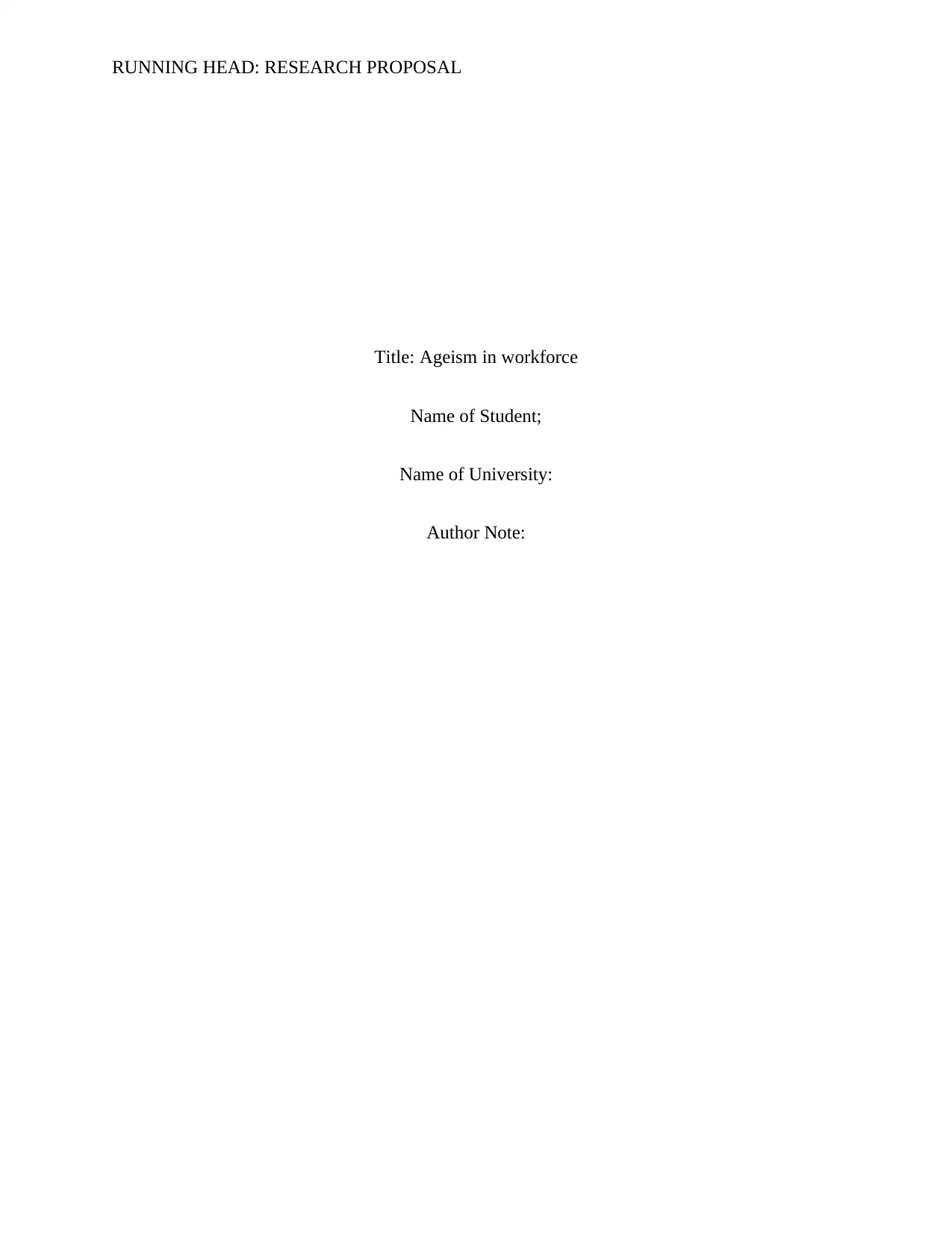
RUNNING HEAD: RESEARCH PROPOSAL
Title: Ageism in workforce
Name of Student;
Name of University:
Author Note:
Title: Ageism in workforce
Name of Student;
Name of University:
Author Note:
Paraphrase This Document
Need a fresh take? Get an instant paraphrase of this document with our AI Paraphraser
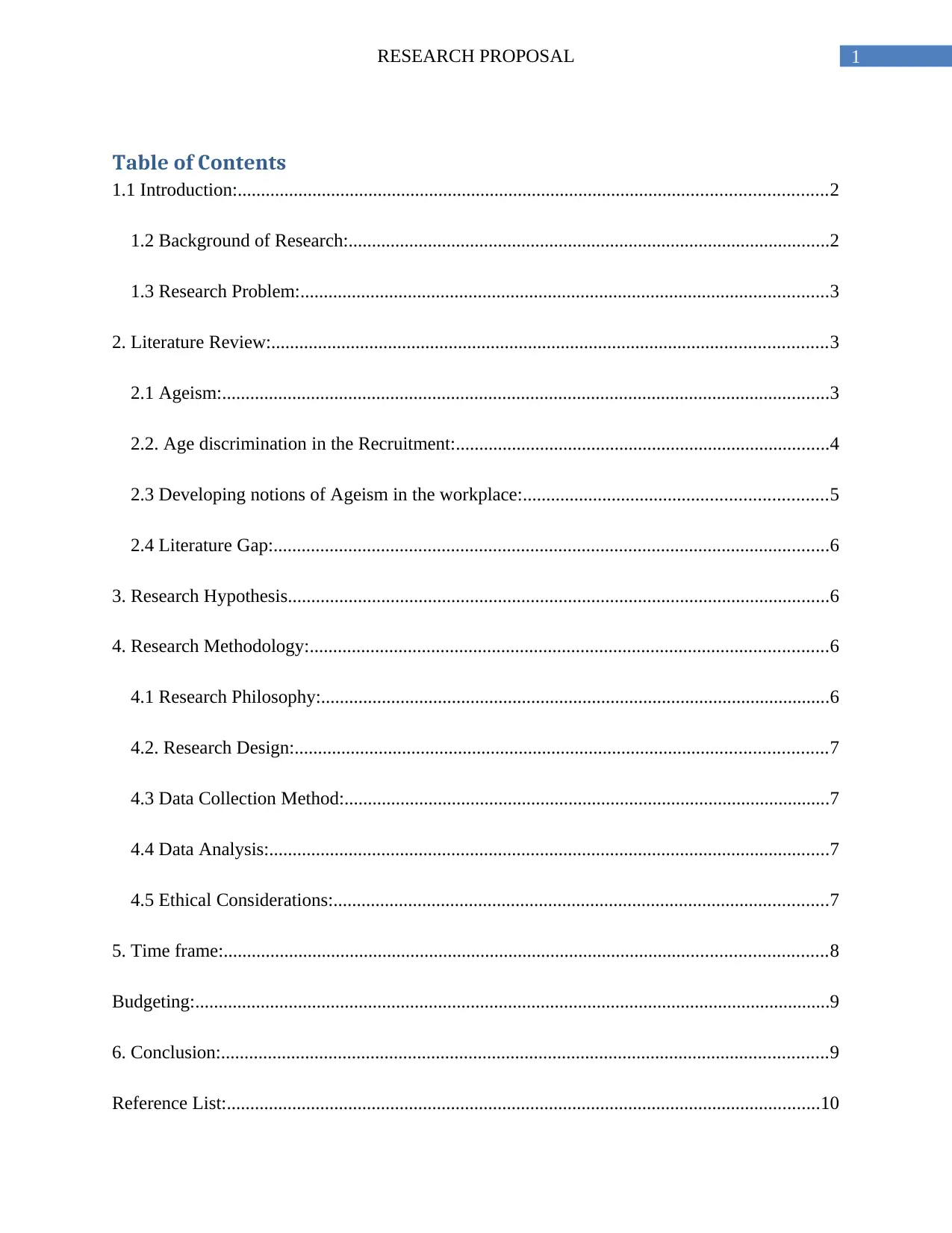
1RESEARCH PROPOSAL
Table of Contents
1.1 Introduction:..............................................................................................................................2
1.2 Background of Research:.......................................................................................................2
1.3 Research Problem:.................................................................................................................3
2. Literature Review:.......................................................................................................................3
2.1 Ageism:..................................................................................................................................3
2.2. Age discrimination in the Recruitment:................................................................................4
2.3 Developing notions of Ageism in the workplace:.................................................................5
2.4 Literature Gap:.......................................................................................................................6
3. Research Hypothesis....................................................................................................................6
4. Research Methodology:...............................................................................................................6
4.1 Research Philosophy:.............................................................................................................6
4.2. Research Design:..................................................................................................................7
4.3 Data Collection Method:........................................................................................................7
4.4 Data Analysis:........................................................................................................................7
4.5 Ethical Considerations:..........................................................................................................7
5. Time frame:.................................................................................................................................8
Budgeting:........................................................................................................................................9
6. Conclusion:..................................................................................................................................9
Reference List:...............................................................................................................................10
Table of Contents
1.1 Introduction:..............................................................................................................................2
1.2 Background of Research:.......................................................................................................2
1.3 Research Problem:.................................................................................................................3
2. Literature Review:.......................................................................................................................3
2.1 Ageism:..................................................................................................................................3
2.2. Age discrimination in the Recruitment:................................................................................4
2.3 Developing notions of Ageism in the workplace:.................................................................5
2.4 Literature Gap:.......................................................................................................................6
3. Research Hypothesis....................................................................................................................6
4. Research Methodology:...............................................................................................................6
4.1 Research Philosophy:.............................................................................................................6
4.2. Research Design:..................................................................................................................7
4.3 Data Collection Method:........................................................................................................7
4.4 Data Analysis:........................................................................................................................7
4.5 Ethical Considerations:..........................................................................................................7
5. Time frame:.................................................................................................................................8
Budgeting:........................................................................................................................................9
6. Conclusion:..................................................................................................................................9
Reference List:...............................................................................................................................10
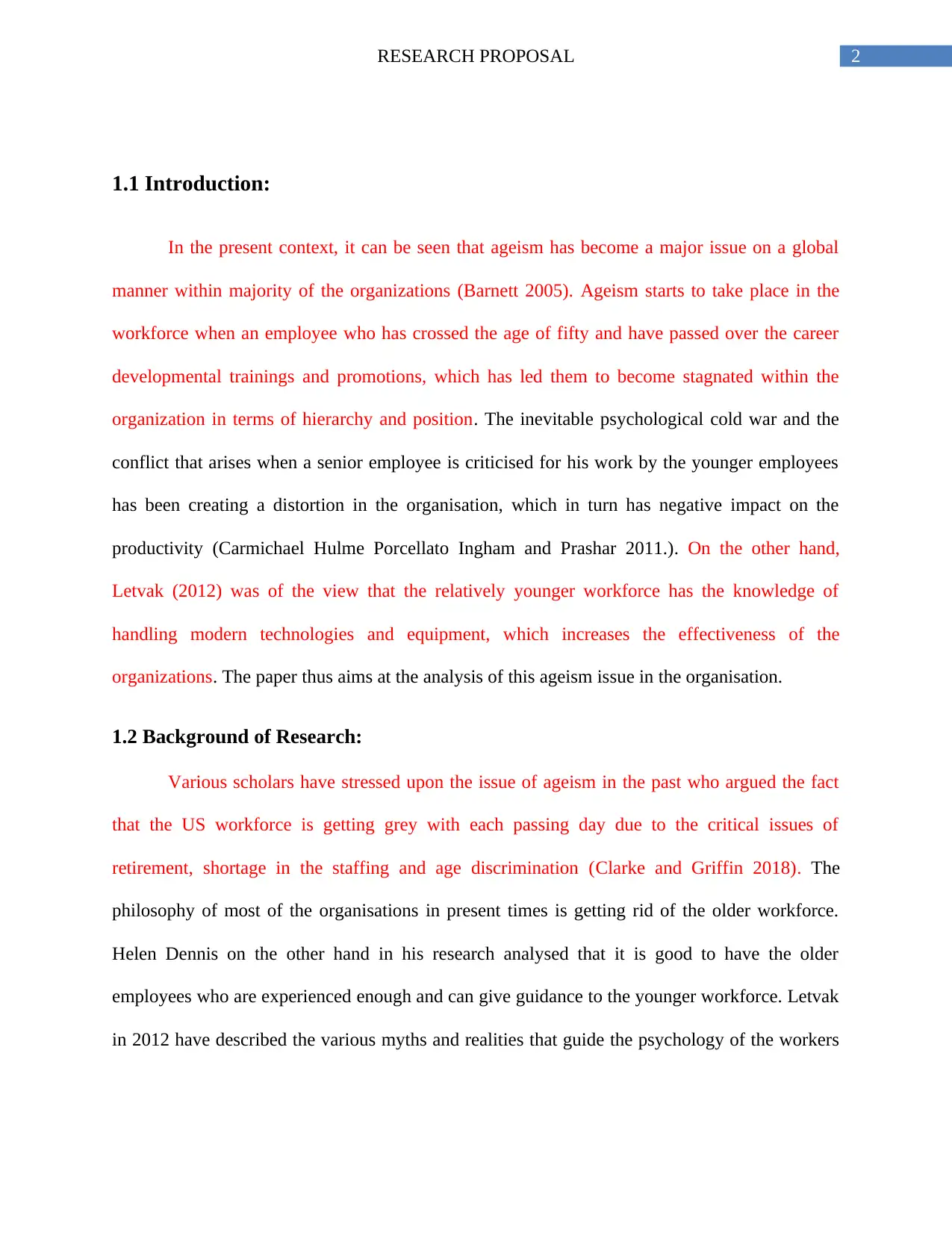
2RESEARCH PROPOSAL
1.1 Introduction:
In the present context, it can be seen that ageism has become a major issue on a global
manner within majority of the organizations (Barnett 2005). Ageism starts to take place in the
workforce when an employee who has crossed the age of fifty and have passed over the career
developmental trainings and promotions, which has led them to become stagnated within the
organization in terms of hierarchy and position. The inevitable psychological cold war and the
conflict that arises when a senior employee is criticised for his work by the younger employees
has been creating a distortion in the organisation, which in turn has negative impact on the
productivity (Carmichael Hulme Porcellato Ingham and Prashar 2011.). On the other hand,
Letvak (2012) was of the view that the relatively younger workforce has the knowledge of
handling modern technologies and equipment, which increases the effectiveness of the
organizations. The paper thus aims at the analysis of this ageism issue in the organisation.
1.2 Background of Research:
Various scholars have stressed upon the issue of ageism in the past who argued the fact
that the US workforce is getting grey with each passing day due to the critical issues of
retirement, shortage in the staffing and age discrimination (Clarke and Griffin 2018). The
philosophy of most of the organisations in present times is getting rid of the older workforce.
Helen Dennis on the other hand in his research analysed that it is good to have the older
employees who are experienced enough and can give guidance to the younger workforce. Letvak
in 2012 have described the various myths and realities that guide the psychology of the workers
1.1 Introduction:
In the present context, it can be seen that ageism has become a major issue on a global
manner within majority of the organizations (Barnett 2005). Ageism starts to take place in the
workforce when an employee who has crossed the age of fifty and have passed over the career
developmental trainings and promotions, which has led them to become stagnated within the
organization in terms of hierarchy and position. The inevitable psychological cold war and the
conflict that arises when a senior employee is criticised for his work by the younger employees
has been creating a distortion in the organisation, which in turn has negative impact on the
productivity (Carmichael Hulme Porcellato Ingham and Prashar 2011.). On the other hand,
Letvak (2012) was of the view that the relatively younger workforce has the knowledge of
handling modern technologies and equipment, which increases the effectiveness of the
organizations. The paper thus aims at the analysis of this ageism issue in the organisation.
1.2 Background of Research:
Various scholars have stressed upon the issue of ageism in the past who argued the fact
that the US workforce is getting grey with each passing day due to the critical issues of
retirement, shortage in the staffing and age discrimination (Clarke and Griffin 2018). The
philosophy of most of the organisations in present times is getting rid of the older workforce.
Helen Dennis on the other hand in his research analysed that it is good to have the older
employees who are experienced enough and can give guidance to the younger workforce. Letvak
in 2012 have described the various myths and realities that guide the psychology of the workers
⊘ This is a preview!⊘
Do you want full access?
Subscribe today to unlock all pages.

Trusted by 1+ million students worldwide
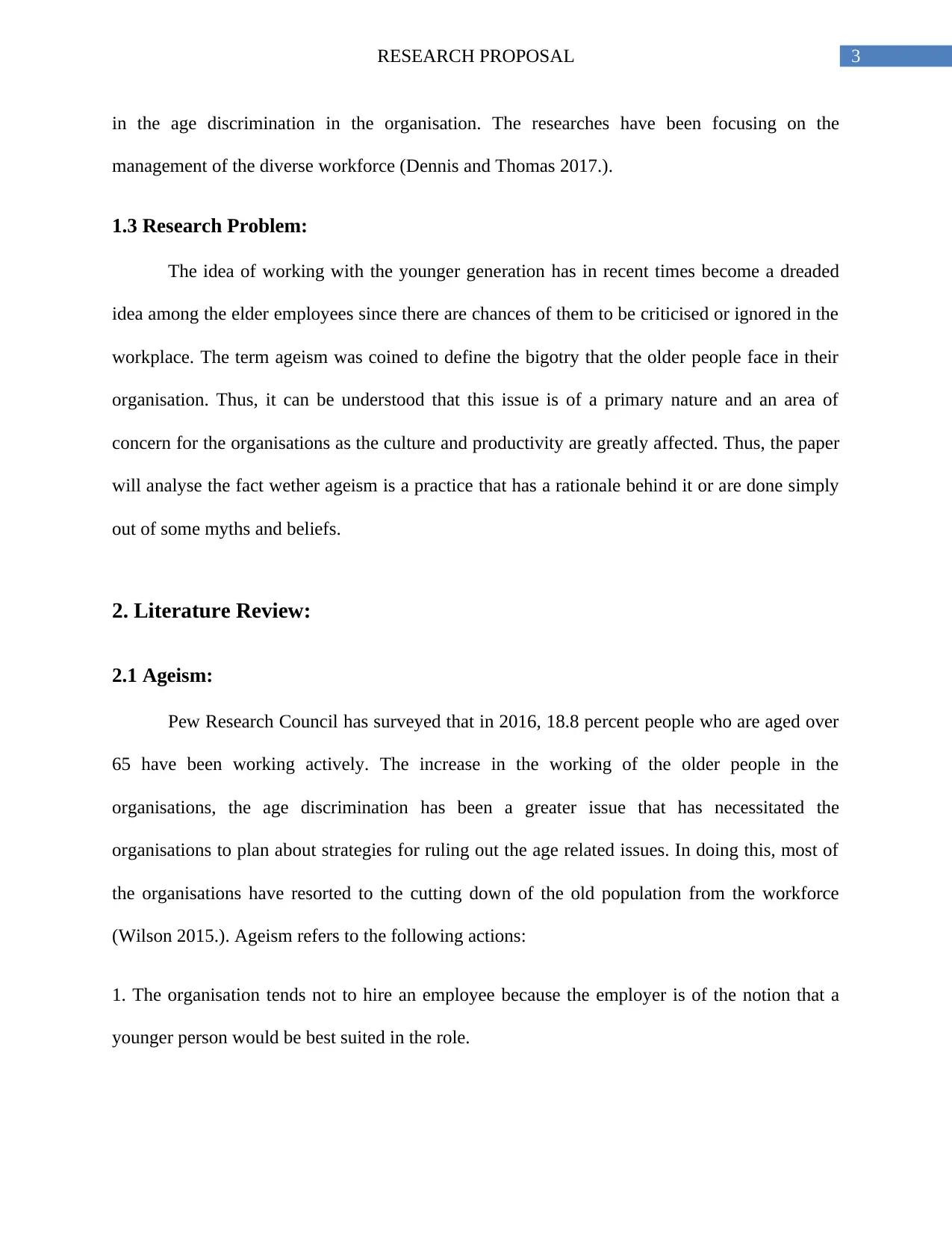
3RESEARCH PROPOSAL
in the age discrimination in the organisation. The researches have been focusing on the
management of the diverse workforce (Dennis and Thomas 2017.).
1.3 Research Problem:
The idea of working with the younger generation has in recent times become a dreaded
idea among the elder employees since there are chances of them to be criticised or ignored in the
workplace. The term ageism was coined to define the bigotry that the older people face in their
organisation. Thus, it can be understood that this issue is of a primary nature and an area of
concern for the organisations as the culture and productivity are greatly affected. Thus, the paper
will analyse the fact wether ageism is a practice that has a rationale behind it or are done simply
out of some myths and beliefs.
2. Literature Review:
2.1 Ageism:
Pew Research Council has surveyed that in 2016, 18.8 percent people who are aged over
65 have been working actively. The increase in the working of the older people in the
organisations, the age discrimination has been a greater issue that has necessitated the
organisations to plan about strategies for ruling out the age related issues. In doing this, most of
the organisations have resorted to the cutting down of the old population from the workforce
(Wilson 2015.). Ageism refers to the following actions:
1. The organisation tends not to hire an employee because the employer is of the notion that a
younger person would be best suited in the role.
in the age discrimination in the organisation. The researches have been focusing on the
management of the diverse workforce (Dennis and Thomas 2017.).
1.3 Research Problem:
The idea of working with the younger generation has in recent times become a dreaded
idea among the elder employees since there are chances of them to be criticised or ignored in the
workplace. The term ageism was coined to define the bigotry that the older people face in their
organisation. Thus, it can be understood that this issue is of a primary nature and an area of
concern for the organisations as the culture and productivity are greatly affected. Thus, the paper
will analyse the fact wether ageism is a practice that has a rationale behind it or are done simply
out of some myths and beliefs.
2. Literature Review:
2.1 Ageism:
Pew Research Council has surveyed that in 2016, 18.8 percent people who are aged over
65 have been working actively. The increase in the working of the older people in the
organisations, the age discrimination has been a greater issue that has necessitated the
organisations to plan about strategies for ruling out the age related issues. In doing this, most of
the organisations have resorted to the cutting down of the old population from the workforce
(Wilson 2015.). Ageism refers to the following actions:
1. The organisation tends not to hire an employee because the employer is of the notion that a
younger person would be best suited in the role.
Paraphrase This Document
Need a fresh take? Get an instant paraphrase of this document with our AI Paraphraser
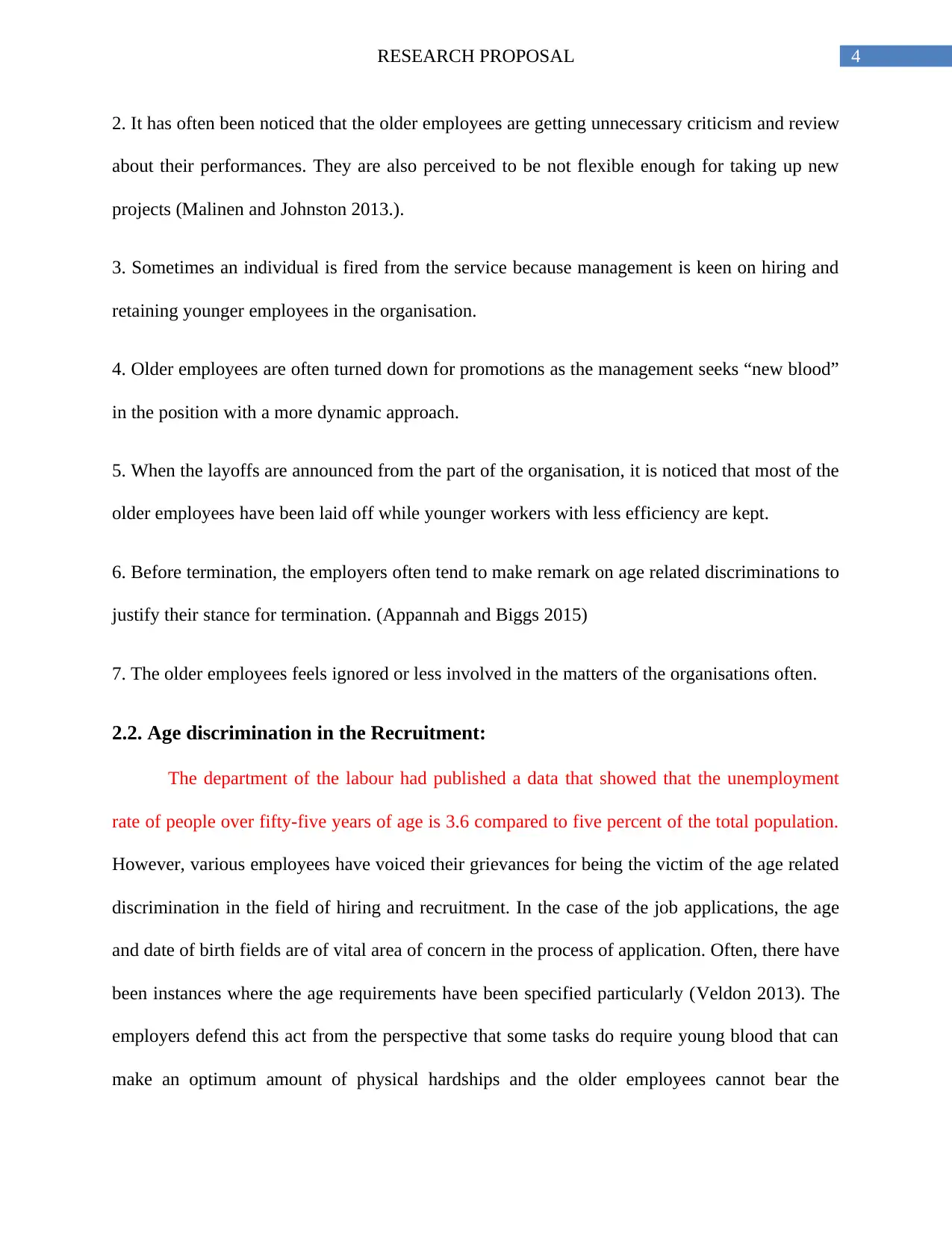
4RESEARCH PROPOSAL
2. It has often been noticed that the older employees are getting unnecessary criticism and review
about their performances. They are also perceived to be not flexible enough for taking up new
projects (Malinen and Johnston 2013.).
3. Sometimes an individual is fired from the service because management is keen on hiring and
retaining younger employees in the organisation.
4. Older employees are often turned down for promotions as the management seeks “new blood”
in the position with a more dynamic approach.
5. When the layoffs are announced from the part of the organisation, it is noticed that most of the
older employees have been laid off while younger workers with less efficiency are kept.
6. Before termination, the employers often tend to make remark on age related discriminations to
justify their stance for termination. (Appannah and Biggs 2015)
7. The older employees feels ignored or less involved in the matters of the organisations often.
2.2. Age discrimination in the Recruitment:
The department of the labour had published a data that showed that the unemployment
rate of people over fifty-five years of age is 3.6 compared to five percent of the total population.
However, various employees have voiced their grievances for being the victim of the age related
discrimination in the field of hiring and recruitment. In the case of the job applications, the age
and date of birth fields are of vital area of concern in the process of application. Often, there have
been instances where the age requirements have been specified particularly (Veldon 2013). The
employers defend this act from the perspective that some tasks do require young blood that can
make an optimum amount of physical hardships and the older employees cannot bear the
2. It has often been noticed that the older employees are getting unnecessary criticism and review
about their performances. They are also perceived to be not flexible enough for taking up new
projects (Malinen and Johnston 2013.).
3. Sometimes an individual is fired from the service because management is keen on hiring and
retaining younger employees in the organisation.
4. Older employees are often turned down for promotions as the management seeks “new blood”
in the position with a more dynamic approach.
5. When the layoffs are announced from the part of the organisation, it is noticed that most of the
older employees have been laid off while younger workers with less efficiency are kept.
6. Before termination, the employers often tend to make remark on age related discriminations to
justify their stance for termination. (Appannah and Biggs 2015)
7. The older employees feels ignored or less involved in the matters of the organisations often.
2.2. Age discrimination in the Recruitment:
The department of the labour had published a data that showed that the unemployment
rate of people over fifty-five years of age is 3.6 compared to five percent of the total population.
However, various employees have voiced their grievances for being the victim of the age related
discrimination in the field of hiring and recruitment. In the case of the job applications, the age
and date of birth fields are of vital area of concern in the process of application. Often, there have
been instances where the age requirements have been specified particularly (Veldon 2013). The
employers defend this act from the perspective that some tasks do require young blood that can
make an optimum amount of physical hardships and the older employees cannot bear the
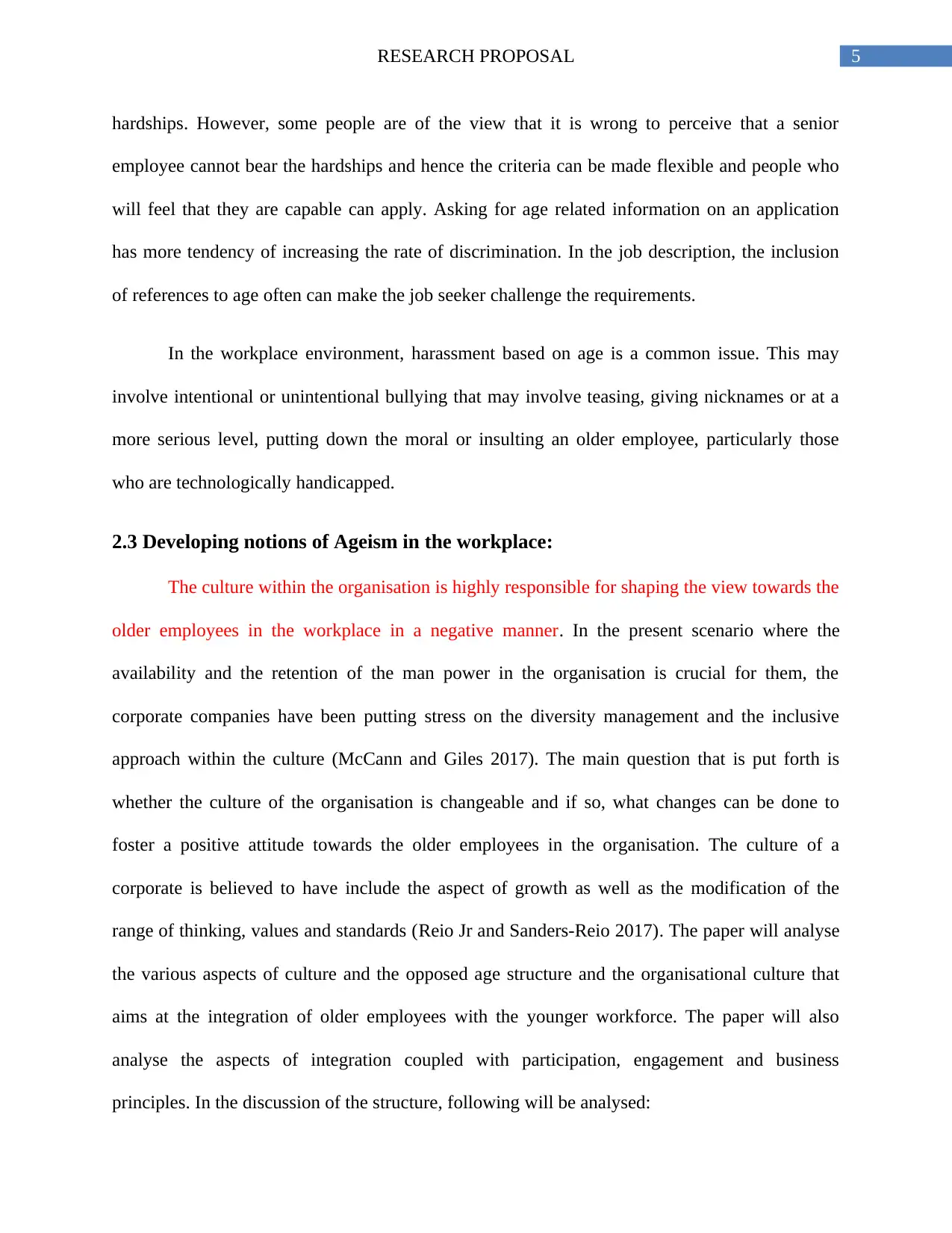
5RESEARCH PROPOSAL
hardships. However, some people are of the view that it is wrong to perceive that a senior
employee cannot bear the hardships and hence the criteria can be made flexible and people who
will feel that they are capable can apply. Asking for age related information on an application
has more tendency of increasing the rate of discrimination. In the job description, the inclusion
of references to age often can make the job seeker challenge the requirements.
In the workplace environment, harassment based on age is a common issue. This may
involve intentional or unintentional bullying that may involve teasing, giving nicknames or at a
more serious level, putting down the moral or insulting an older employee, particularly those
who are technologically handicapped.
2.3 Developing notions of Ageism in the workplace:
The culture within the organisation is highly responsible for shaping the view towards the
older employees in the workplace in a negative manner. In the present scenario where the
availability and the retention of the man power in the organisation is crucial for them, the
corporate companies have been putting stress on the diversity management and the inclusive
approach within the culture (McCann and Giles 2017). The main question that is put forth is
whether the culture of the organisation is changeable and if so, what changes can be done to
foster a positive attitude towards the older employees in the organisation. The culture of a
corporate is believed to have include the aspect of growth as well as the modification of the
range of thinking, values and standards (Reio Jr and Sanders-Reio 2017). The paper will analyse
the various aspects of culture and the opposed age structure and the organisational culture that
aims at the integration of older employees with the younger workforce. The paper will also
analyse the aspects of integration coupled with participation, engagement and business
principles. In the discussion of the structure, following will be analysed:
hardships. However, some people are of the view that it is wrong to perceive that a senior
employee cannot bear the hardships and hence the criteria can be made flexible and people who
will feel that they are capable can apply. Asking for age related information on an application
has more tendency of increasing the rate of discrimination. In the job description, the inclusion
of references to age often can make the job seeker challenge the requirements.
In the workplace environment, harassment based on age is a common issue. This may
involve intentional or unintentional bullying that may involve teasing, giving nicknames or at a
more serious level, putting down the moral or insulting an older employee, particularly those
who are technologically handicapped.
2.3 Developing notions of Ageism in the workplace:
The culture within the organisation is highly responsible for shaping the view towards the
older employees in the workplace in a negative manner. In the present scenario where the
availability and the retention of the man power in the organisation is crucial for them, the
corporate companies have been putting stress on the diversity management and the inclusive
approach within the culture (McCann and Giles 2017). The main question that is put forth is
whether the culture of the organisation is changeable and if so, what changes can be done to
foster a positive attitude towards the older employees in the organisation. The culture of a
corporate is believed to have include the aspect of growth as well as the modification of the
range of thinking, values and standards (Reio Jr and Sanders-Reio 2017). The paper will analyse
the various aspects of culture and the opposed age structure and the organisational culture that
aims at the integration of older employees with the younger workforce. The paper will also
analyse the aspects of integration coupled with participation, engagement and business
principles. In the discussion of the structure, following will be analysed:
⊘ This is a preview!⊘
Do you want full access?
Subscribe today to unlock all pages.

Trusted by 1+ million students worldwide
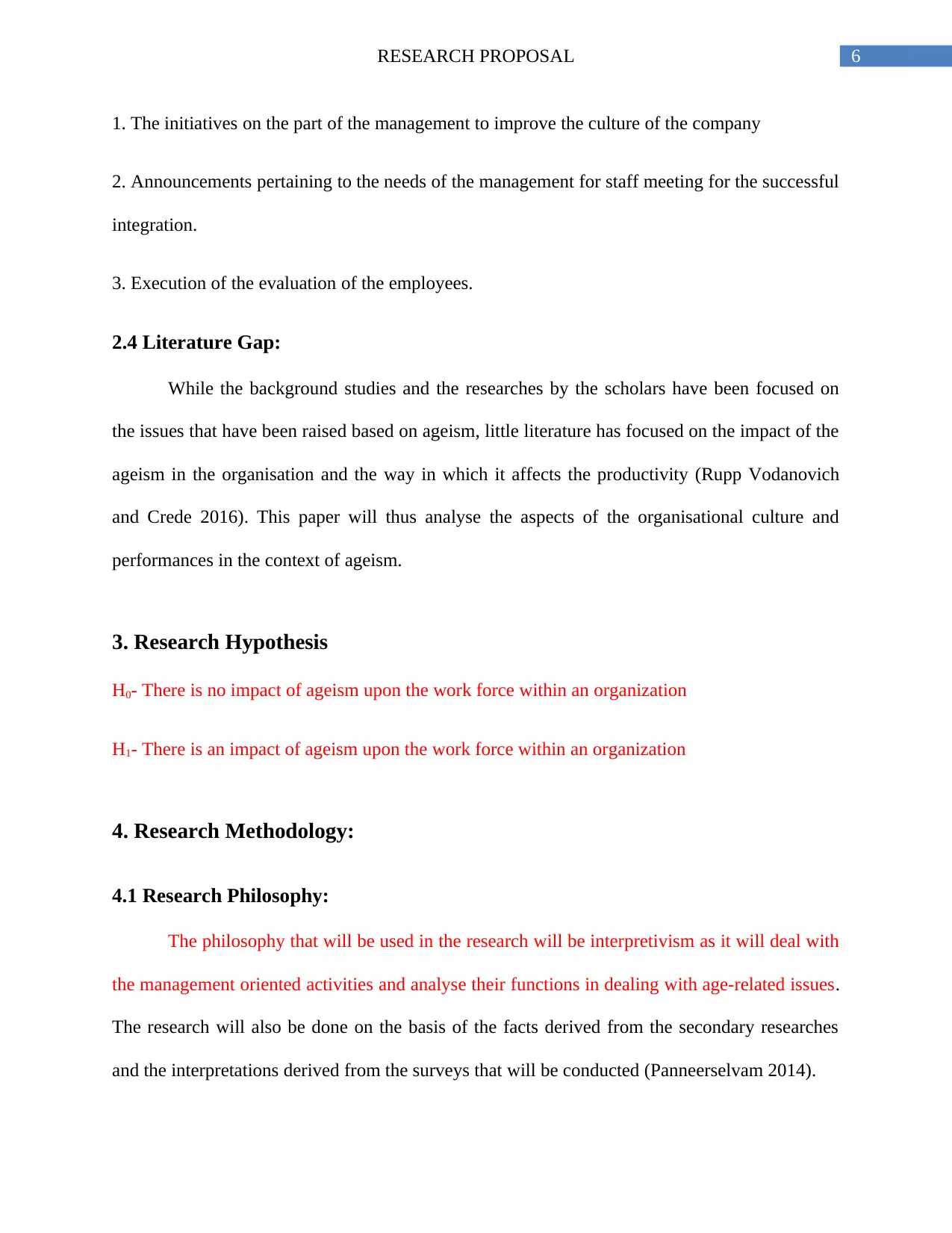
6RESEARCH PROPOSAL
1. The initiatives on the part of the management to improve the culture of the company
2. Announcements pertaining to the needs of the management for staff meeting for the successful
integration.
3. Execution of the evaluation of the employees.
2.4 Literature Gap:
While the background studies and the researches by the scholars have been focused on
the issues that have been raised based on ageism, little literature has focused on the impact of the
ageism in the organisation and the way in which it affects the productivity (Rupp Vodanovich
and Crede 2016). This paper will thus analyse the aspects of the organisational culture and
performances in the context of ageism.
3. Research Hypothesis
H0- There is no impact of ageism upon the work force within an organization
H1- There is an impact of ageism upon the work force within an organization
4. Research Methodology:
4.1 Research Philosophy:
The philosophy that will be used in the research will be interpretivism as it will deal with
the management oriented activities and analyse their functions in dealing with age-related issues.
The research will also be done on the basis of the facts derived from the secondary researches
and the interpretations derived from the surveys that will be conducted (Panneerselvam 2014).
1. The initiatives on the part of the management to improve the culture of the company
2. Announcements pertaining to the needs of the management for staff meeting for the successful
integration.
3. Execution of the evaluation of the employees.
2.4 Literature Gap:
While the background studies and the researches by the scholars have been focused on
the issues that have been raised based on ageism, little literature has focused on the impact of the
ageism in the organisation and the way in which it affects the productivity (Rupp Vodanovich
and Crede 2016). This paper will thus analyse the aspects of the organisational culture and
performances in the context of ageism.
3. Research Hypothesis
H0- There is no impact of ageism upon the work force within an organization
H1- There is an impact of ageism upon the work force within an organization
4. Research Methodology:
4.1 Research Philosophy:
The philosophy that will be used in the research will be interpretivism as it will deal with
the management oriented activities and analyse their functions in dealing with age-related issues.
The research will also be done on the basis of the facts derived from the secondary researches
and the interpretations derived from the surveys that will be conducted (Panneerselvam 2014).
Paraphrase This Document
Need a fresh take? Get an instant paraphrase of this document with our AI Paraphraser
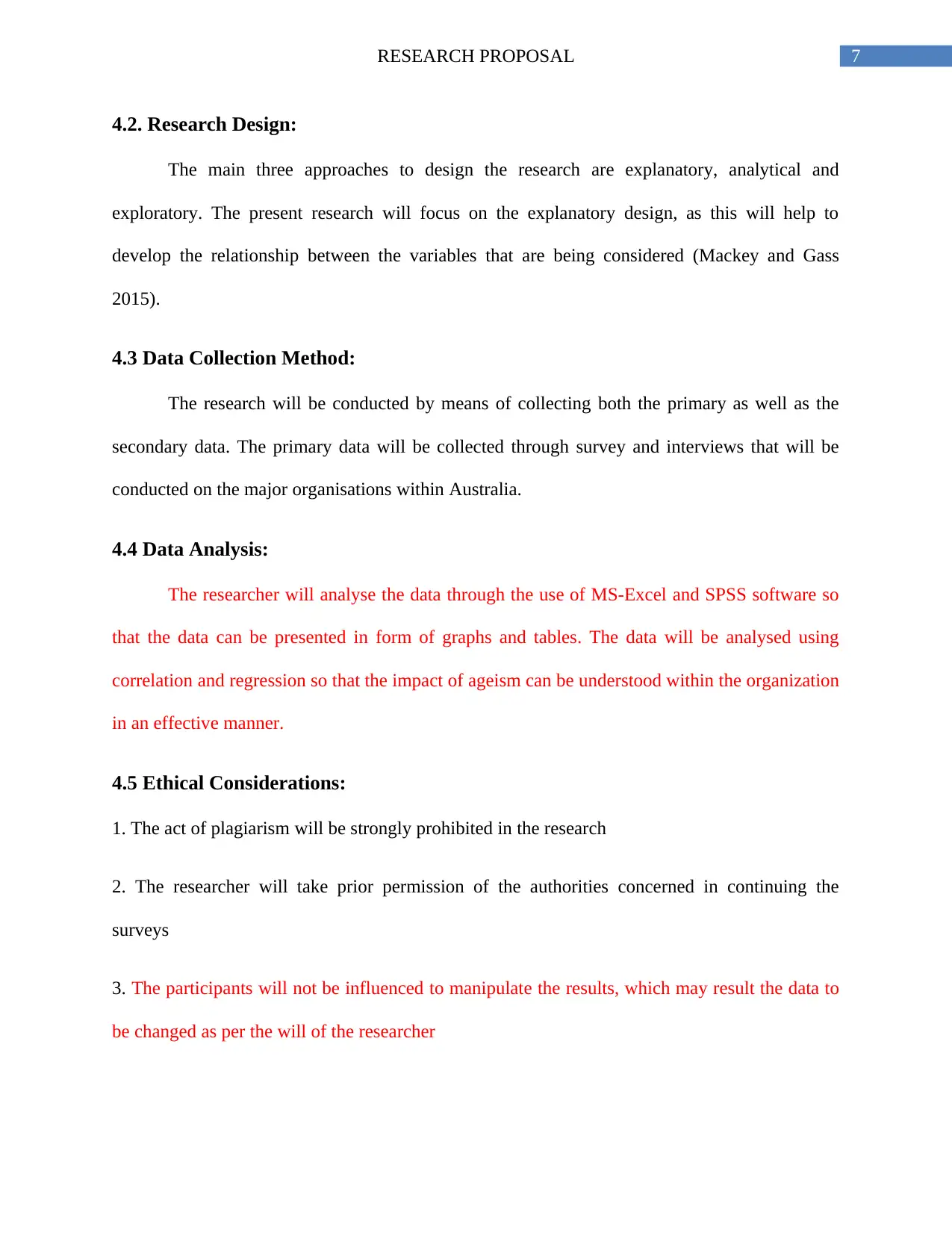
7RESEARCH PROPOSAL
4.2. Research Design:
The main three approaches to design the research are explanatory, analytical and
exploratory. The present research will focus on the explanatory design, as this will help to
develop the relationship between the variables that are being considered (Mackey and Gass
2015).
4.3 Data Collection Method:
The research will be conducted by means of collecting both the primary as well as the
secondary data. The primary data will be collected through survey and interviews that will be
conducted on the major organisations within Australia.
4.4 Data Analysis:
The researcher will analyse the data through the use of MS-Excel and SPSS software so
that the data can be presented in form of graphs and tables. The data will be analysed using
correlation and regression so that the impact of ageism can be understood within the organization
in an effective manner.
4.5 Ethical Considerations:
1. The act of plagiarism will be strongly prohibited in the research
2. The researcher will take prior permission of the authorities concerned in continuing the
surveys
3. The participants will not be influenced to manipulate the results, which may result the data to
be changed as per the will of the researcher
4.2. Research Design:
The main three approaches to design the research are explanatory, analytical and
exploratory. The present research will focus on the explanatory design, as this will help to
develop the relationship between the variables that are being considered (Mackey and Gass
2015).
4.3 Data Collection Method:
The research will be conducted by means of collecting both the primary as well as the
secondary data. The primary data will be collected through survey and interviews that will be
conducted on the major organisations within Australia.
4.4 Data Analysis:
The researcher will analyse the data through the use of MS-Excel and SPSS software so
that the data can be presented in form of graphs and tables. The data will be analysed using
correlation and regression so that the impact of ageism can be understood within the organization
in an effective manner.
4.5 Ethical Considerations:
1. The act of plagiarism will be strongly prohibited in the research
2. The researcher will take prior permission of the authorities concerned in continuing the
surveys
3. The participants will not be influenced to manipulate the results, which may result the data to
be changed as per the will of the researcher
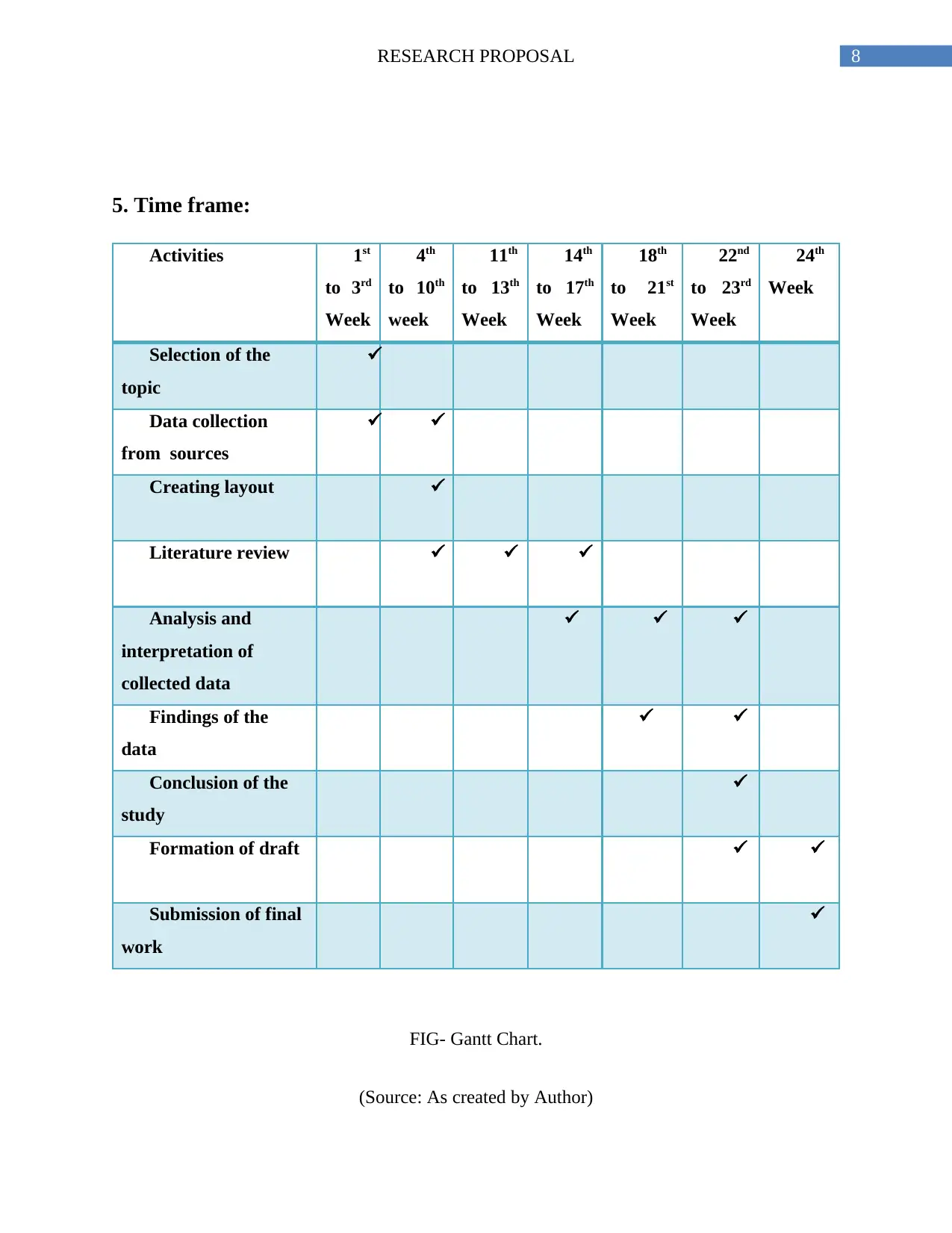
8RESEARCH PROPOSAL
5. Time frame:
Activities 1st
to 3rd
Week
4th
to 10th
week
11th
to 13th
Week
14th
to 17th
Week
18th
to 21st
Week
22nd
to 23rd
Week
24th
Week
Selection of the
topic
Data collection
from sources
Creating layout
Literature review
Analysis and
interpretation of
collected data
Findings of the
data
Conclusion of the
study
Formation of draft
Submission of final
work
FIG- Gantt Chart.
(Source: As created by Author)
5. Time frame:
Activities 1st
to 3rd
Week
4th
to 10th
week
11th
to 13th
Week
14th
to 17th
Week
18th
to 21st
Week
22nd
to 23rd
Week
24th
Week
Selection of the
topic
Data collection
from sources
Creating layout
Literature review
Analysis and
interpretation of
collected data
Findings of the
data
Conclusion of the
study
Formation of draft
Submission of final
work
FIG- Gantt Chart.
(Source: As created by Author)
⊘ This is a preview!⊘
Do you want full access?
Subscribe today to unlock all pages.

Trusted by 1+ million students worldwide
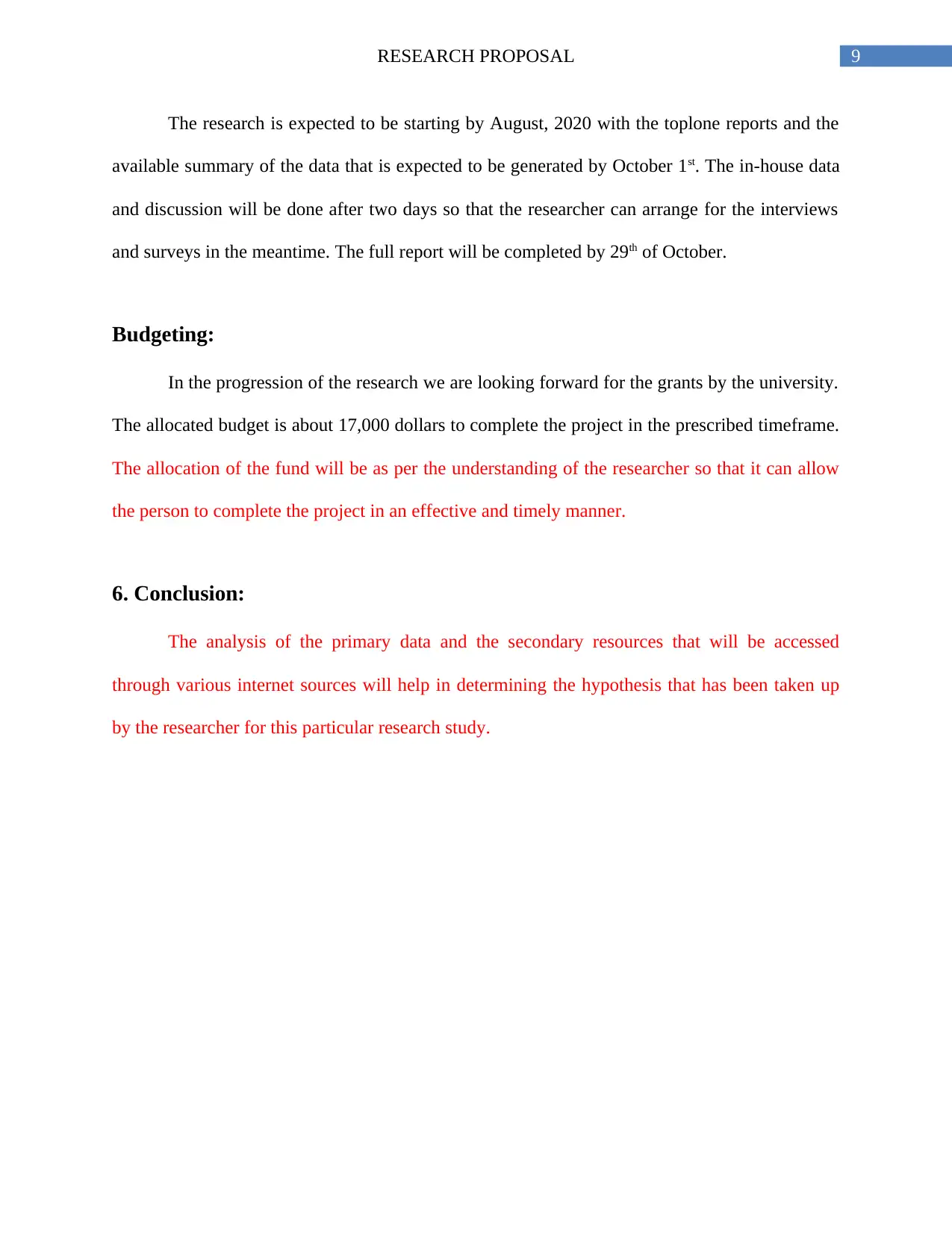
9RESEARCH PROPOSAL
The research is expected to be starting by August, 2020 with the toplone reports and the
available summary of the data that is expected to be generated by October 1st. The in-house data
and discussion will be done after two days so that the researcher can arrange for the interviews
and surveys in the meantime. The full report will be completed by 29th of October.
Budgeting:
In the progression of the research we are looking forward for the grants by the university.
The allocated budget is about 17,000 dollars to complete the project in the prescribed timeframe.
The allocation of the fund will be as per the understanding of the researcher so that it can allow
the person to complete the project in an effective and timely manner.
6. Conclusion:
The analysis of the primary data and the secondary resources that will be accessed
through various internet sources will help in determining the hypothesis that has been taken up
by the researcher for this particular research study.
The research is expected to be starting by August, 2020 with the toplone reports and the
available summary of the data that is expected to be generated by October 1st. The in-house data
and discussion will be done after two days so that the researcher can arrange for the interviews
and surveys in the meantime. The full report will be completed by 29th of October.
Budgeting:
In the progression of the research we are looking forward for the grants by the university.
The allocated budget is about 17,000 dollars to complete the project in the prescribed timeframe.
The allocation of the fund will be as per the understanding of the researcher so that it can allow
the person to complete the project in an effective and timely manner.
6. Conclusion:
The analysis of the primary data and the secondary resources that will be accessed
through various internet sources will help in determining the hypothesis that has been taken up
by the researcher for this particular research study.
Paraphrase This Document
Need a fresh take? Get an instant paraphrase of this document with our AI Paraphraser
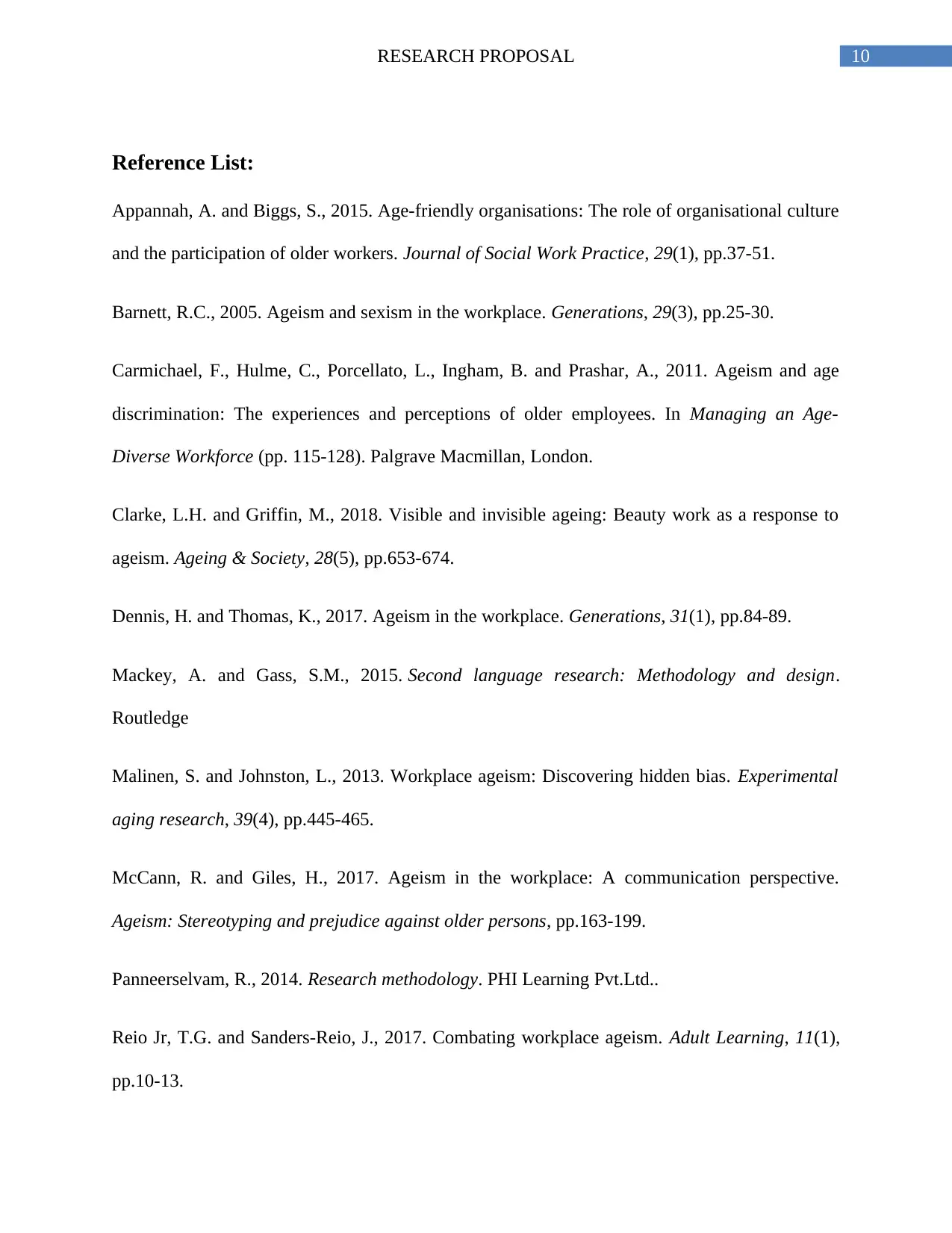
10RESEARCH PROPOSAL
Reference List:
Appannah, A. and Biggs, S., 2015. Age-friendly organisations: The role of organisational culture
and the participation of older workers. Journal of Social Work Practice, 29(1), pp.37-51.
Barnett, R.C., 2005. Ageism and sexism in the workplace. Generations, 29(3), pp.25-30.
Carmichael, F., Hulme, C., Porcellato, L., Ingham, B. and Prashar, A., 2011. Ageism and age
discrimination: The experiences and perceptions of older employees. In Managing an Age-
Diverse Workforce (pp. 115-128). Palgrave Macmillan, London.
Clarke, L.H. and Griffin, M., 2018. Visible and invisible ageing: Beauty work as a response to
ageism. Ageing & Society, 28(5), pp.653-674.
Dennis, H. and Thomas, K., 2017. Ageism in the workplace. Generations, 31(1), pp.84-89.
Mackey, A. and Gass, S.M., 2015. Second language research: Methodology and design.
Routledge
Malinen, S. and Johnston, L., 2013. Workplace ageism: Discovering hidden bias. Experimental
aging research, 39(4), pp.445-465.
McCann, R. and Giles, H., 2017. Ageism in the workplace: A communication perspective.
Ageism: Stereotyping and prejudice against older persons, pp.163-199.
Panneerselvam, R., 2014. Research methodology. PHI Learning Pvt.Ltd..
Reio Jr, T.G. and Sanders-Reio, J., 2017. Combating workplace ageism. Adult Learning, 11(1),
pp.10-13.
Reference List:
Appannah, A. and Biggs, S., 2015. Age-friendly organisations: The role of organisational culture
and the participation of older workers. Journal of Social Work Practice, 29(1), pp.37-51.
Barnett, R.C., 2005. Ageism and sexism in the workplace. Generations, 29(3), pp.25-30.
Carmichael, F., Hulme, C., Porcellato, L., Ingham, B. and Prashar, A., 2011. Ageism and age
discrimination: The experiences and perceptions of older employees. In Managing an Age-
Diverse Workforce (pp. 115-128). Palgrave Macmillan, London.
Clarke, L.H. and Griffin, M., 2018. Visible and invisible ageing: Beauty work as a response to
ageism. Ageing & Society, 28(5), pp.653-674.
Dennis, H. and Thomas, K., 2017. Ageism in the workplace. Generations, 31(1), pp.84-89.
Mackey, A. and Gass, S.M., 2015. Second language research: Methodology and design.
Routledge
Malinen, S. and Johnston, L., 2013. Workplace ageism: Discovering hidden bias. Experimental
aging research, 39(4), pp.445-465.
McCann, R. and Giles, H., 2017. Ageism in the workplace: A communication perspective.
Ageism: Stereotyping and prejudice against older persons, pp.163-199.
Panneerselvam, R., 2014. Research methodology. PHI Learning Pvt.Ltd..
Reio Jr, T.G. and Sanders-Reio, J., 2017. Combating workplace ageism. Adult Learning, 11(1),
pp.10-13.
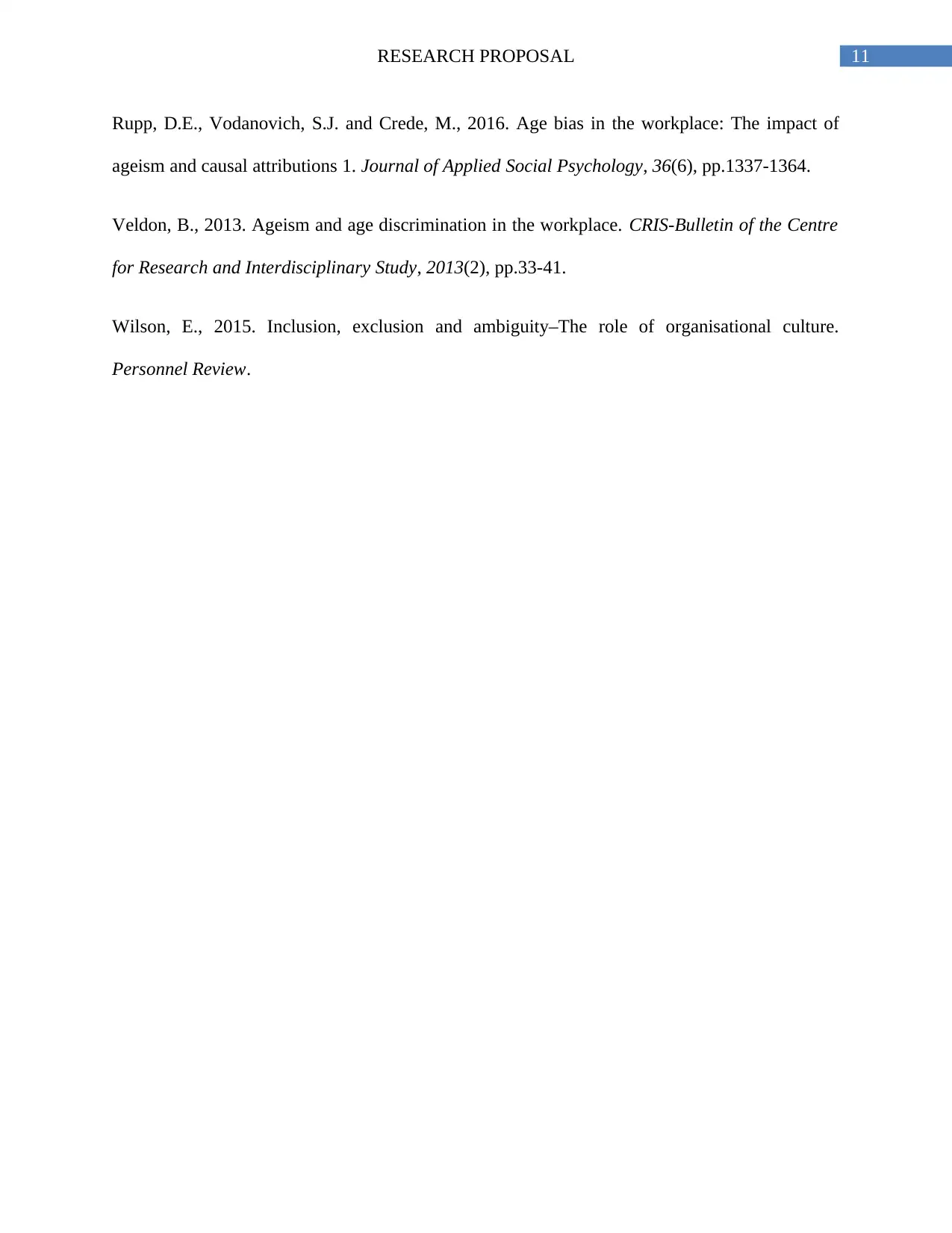
11RESEARCH PROPOSAL
Rupp, D.E., Vodanovich, S.J. and Crede, M., 2016. Age bias in the workplace: The impact of
ageism and causal attributions 1. Journal of Applied Social Psychology, 36(6), pp.1337-1364.
Veldon, B., 2013. Ageism and age discrimination in the workplace. CRIS-Bulletin of the Centre
for Research and Interdisciplinary Study, 2013(2), pp.33-41.
Wilson, E., 2015. Inclusion, exclusion and ambiguity–The role of organisational culture.
Personnel Review.
Rupp, D.E., Vodanovich, S.J. and Crede, M., 2016. Age bias in the workplace: The impact of
ageism and causal attributions 1. Journal of Applied Social Psychology, 36(6), pp.1337-1364.
Veldon, B., 2013. Ageism and age discrimination in the workplace. CRIS-Bulletin of the Centre
for Research and Interdisciplinary Study, 2013(2), pp.33-41.
Wilson, E., 2015. Inclusion, exclusion and ambiguity–The role of organisational culture.
Personnel Review.
⊘ This is a preview!⊘
Do you want full access?
Subscribe today to unlock all pages.

Trusted by 1+ million students worldwide
1 out of 12
Related Documents
Your All-in-One AI-Powered Toolkit for Academic Success.
+13062052269
info@desklib.com
Available 24*7 on WhatsApp / Email
![[object Object]](/_next/static/media/star-bottom.7253800d.svg)
Unlock your academic potential
Copyright © 2020–2025 A2Z Services. All Rights Reserved. Developed and managed by ZUCOL.





